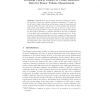Free Online Productivity Tools
i2Speak
i2Symbol
i2OCR
iTex2Img
iWeb2Print
iWeb2Shot
i2Type
iPdf2Split
iPdf2Merge
i2Bopomofo
i2Arabic
i2Style
i2Image
i2PDF
iLatex2Rtf
Sci2ools
95
Voted
ISVC
2010
Springer
2010
Springer
Modeling Clinical Tumors to Create Reference Data for Tumor Volume Measurement
Abstract. Expanding on our previously developed method for inserting synthetic objects into clinical computed tomography (CT) data, we model a set of eight clinical tumors that span a range of geometries and locations within the lung. The goal is to create realistic but synthetic tumor data, with known volumes. The set of data we created can be used as ground truth data to compare volumetric methods, particularly for lung tumors attached to vascular material in the lung or attached to lung walls, where ambiguities for volume measurement occur. In the process of creating these data sets, we select a sample of often seen lung tumor shapes and locations in the lung, and show that for this sample a large fraction of the voxels representing tumors in the gridded data are partially filled voxels. This points out the need for volumetric methods that handle partial volumes accurately.
Applied Computing | ISVC 2010 | Lung | Lung Tumor | Tumors |
Related Content
| Added | 28 Jan 2011 |
| Updated | 28 Jan 2011 |
| Type | Journal |
| Year | 2010 |
| Where | ISVC |
| Authors | Adele P. Peskin, Alden Dima |
Comments (0)

